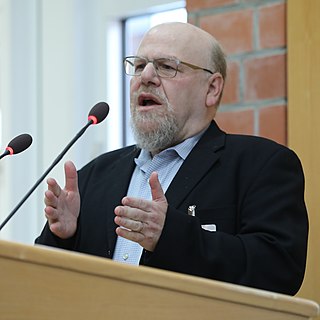Artificial intelligence (AI) is intelligence demonstrated by machines, as opposed to the natural intelligence displayed by animals including humans. AI research has been defined as the field of study of intelligent agents, which refers to any system that perceives its environment and takes actions that maximize its chance of achieving its goals.

Computer security, cybersecurity, or information technology security is the protection of computer systems and networks from information disclosure, theft of, or damage to their hardware, software, or electronic data, as well as from the disruption or misdirection of the services they provide.

The Defense Advanced Research Projects Agency (DARPA) is a research and development agency of the United States Department of Defense responsible for the development of emerging technologies for use by the military.

Stephen D. Crocker is the inventor of the Request for Comments series, authoring the first RFC and many more. He attended Van Nuys High School, as did Vint Cerf and Jon Postel. Crocker received his bachelor's degree (1968) and PhD (1977) from the University of California, Los Angeles. Crocker served as chair of the board of the Internet Corporation for Assigned Names and Numbers, ICANN from 2011 through 2017.

SRI International (SRI) is an American nonprofit scientific research institute and organization headquartered in Menlo Park, California. The trustees of Stanford University established SRI in 1946 as a center of innovation to support economic development in the region.

Peiter C. Zatko, better known as Mudge, is a network security expert, open source programmer, writer, and a hacker. He was the most prominent member of the high-profile hacker think tank the L0pht as well as the long-lived computer and culture hacking cooperative the Cult of the Dead Cow.

James Alexander Hendler is an artificial intelligence researcher at Rensselaer Polytechnic Institute, United States, and one of the originators of the Semantic Web. He is a Fellow of the National Academy of Public Administration.

UST, formerly known as UST Global, is a provider of digital technology and transformation, information technology and services, headquartered in Aliso Viejo, California, United States. Stephen Ross founded UST in 1998 in Laguna Hills. The company has offices in the Americas, EMEA, APAC, and India.
In the history of artificial intelligence, an AI winter is a period of reduced funding and interest in artificial intelligence research. The term was coined by analogy to the idea of a nuclear winter. The field has experienced several hype cycles, followed by disappointment and criticism, followed by funding cuts, followed by renewed interest years or decades later.
Homeland Security Advanced Research Projects Agency (HSARPA) is a part of the Science and Technology Directorate at the United States Department of Homeland Security. Much like DARPA in the Department of Defense, HSARPA is tasked with advanced projects to advance the technology needed to protect the US. Some of the chief beneficiaries of HSARPA are the Customs and Border Protection, and the Office of Intelligence and Analysis.

The Intelligence Advanced Research Projects Activity (IARPA) is an organization within the Office of the Director of National Intelligence responsible for leading research to overcome difficult challenges relevant to the United States Intelligence Community. IARPA characterizes its mission as follows: "To envision and lead high-risk, high-payoff research that delivers innovative technology for future overwhelming intelligence advantage."
ManTech International Corporation is an American defense contracting firm that was co-founded in 1968 by Franc Wertheimer and George J. Pedersen. The company uses technology to help government and industry clients. The company name "ManTech" is a portmanteau formed through the combination of "management" and "technology."

Hsinchun Chen is the Regents' Professor and Thomas R. Brown Chair of Management and Technology at the University of Arizona and the Director and founder of the Artificial Intelligence Lab. He also served as lead program director of the Smart and Connected Health program at the National Science Foundation from 2014 to 2015. He received a B.S. degree from National Chiao Tung University in Taiwan, an MBA from SUNY Buffalo and an M.S. and Ph.D. in Information Systems from New York University.
Stephen J. Andriole is an American information technology professional and professor at Villanova University who has designed and developed a variety of interactive computer-based systems for industry and government, from positions in academia, government and industry.

K. Stuart "Stu" Shea is an American business executive and leader and intelligence professional serving in a leadership capacity to public and private companies, as well as an advisor to government agencies, private equity investors, and academic institutions. Shea is chairman, president and chief executive officer of Peraton, a national security technology company. He is the former president and chief operating officer of Leidos, chief operating officer of Science Applications International Corporation (SAIC), and founder and emeritus chairman of the United States Geospatial Intelligence Foundation.

Paul Eremenko is a Ukrainian American Innovator and Technology executive. He was formerly the Chief Technology Officer and Senior Vice President of United Technologies Corporation. Earlier, he served as the CTO of Airbus, and former CEO of Airbus Silicon Valley innovation center. He is a former Google executive and head of Google's Project Ara, an effort to create an open, modular smartphone platform. Eremenko was named one of the Top-10 Tech Leaders of 2015 in FORTUNE Magazine. Eremenko has also come out as a strong proponent of artificial intelligence and autonomy research, brushing away the growing chorus of concerns by many prominent technology and business leaders. Eremenko has cited his desire to build a starship as the motivation underpinning his career.

Salvatore J. Stolfo is an academic and professor of computer science at Columbia University, specializing in computer security.

Stephen Joseph Lukasik was an American physicist who served in multiple high-level defense and scientific related positions for advancing the technologies and techniques for national defense and the detection and control of diverse types of weapons of mass destruction, especially nuclear devices. He was the second longest serving Director of DARPA - the Defense Advanced Research Projects Agency – during which numerous new technologies including packet and internet protocols were developed. He was also the first Chief Scientist of the Federal Communications Commission where he created its Office of Science and Technology and which facilitated the commercial deployment of new technology that included spread spectrum technology.

Farnam Jahanian is an Iranian-American computer scientist, entrepreneur, and higher education leader. He serves as the 10th president of Carnegie Mellon University.
The Internet of Military Things (IoMT) is a class of Internet of things for combat operations and warfare. It is a complex network of interconnected entities, or "things", in the military domain that continually communicate with each other to coordinate, learn, and interact with the physical environment to accomplish a broad range of activities in a more efficient and informed manner. The concept of IoMT is largely driven by the idea that future military battles will be dominated by machine intelligence and cyber warfare and will likely take place in urban environments. By creating a miniature ecosystem of smart technology capable of distilling sensory information and autonomously governing multiple tasks at once, the IoMT is conceptually designed to offload much of the physical and mental burden that warfighters encounter in a combat setting.














